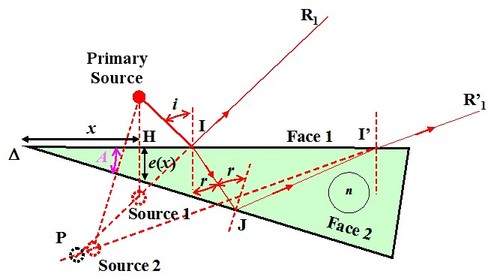
Glass Corner
The prismatic blade of apex angle
 of index
of index
 (figure 8) is lit with almost normal incidence by a monochromatic and extended source.
(figure 8) is lit with almost normal incidence by a monochromatic and extended source.

A part of the incident beam
 is reflected on the first diopter surface and a second part is refracted in
is reflected on the first diopter surface and a second part is refracted in
 then reflected on the second diopter surface in
then reflected on the second diopter surface in
 before it is refracted in
before it is refracted in
 . Both beams
. Both beams
 and
and
 stemming from the same incident beam
stemming from the same incident beam
 converge in
converge in
 where interfringes are formed. Interferences are located close to the blade, around point
where interfringes are formed. Interferences are located close to the blade, around point
 . On figure 8, the incidence angle has been considerably incremented, as well as angle
. On figure 8, the incidence angle has been considerably incremented, as well as angle
 for more clarity; in reality angle
for more clarity; in reality angle
 order of magnitude equals
order of magnitude equals
 of arc .In almost regular incidence, points
of arc .In almost regular incidence, points
 and
and
 are very close and the blade thickness can locally be considered as constant and equal to
are very close and the blade thickness can locally be considered as constant and equal to
 . Thus, the difference of optical path between beams
. Thus, the difference of optical path between beams
 and
and
 is sensibly equal to the one given by blade with parallel sides placed in the air, lit under normal incidence:
is sensibly equal to the one given by blade with parallel sides placed in the air, lit under normal incidence:
As the corner index is
 . The reflection in
. The reflection in
 occurs on a more refringent medium than the incident medium when the second reflection in
occurs on a more refringent medium than the incident medium when the second reflection in
 occurs on a less refringent medium than the incident medium of index
occurs on a less refringent medium than the incident medium of index
 ; both reflections are not of the same kind, which justifies the additional term
; both reflections are not of the same kind, which justifies the additional term
 . For any point of a bright interference fringe, the course difference verifies:
. For any point of a bright interference fringe, the course difference verifies:
For a given blade, the wavelength and the index are constant; the points corresponding to the same state of interferences, consequently at the same order of interferences
 verify:
verify:
Thus, interferences fringes are lines parallel to the intersection line
 of both diopters. These fringes are called “same thickness fringes”. The interfringe
of both diopters. These fringes are called “same thickness fringes”. The interfringe
 is obtained for a variation of order
is obtained for a variation of order
 of one unity hence:
of one unity hence:
Considering that
 because angle
because angle
 is weak, we obtain:
is weak, we obtain:
The interfringe decreases when angle
 increases.
increases.
Both configurations that have just been studied, parallel sides blades and prismatic blades, are particularly important because we can find their concepts in Michelson interferometer and all interferometers derived from it.